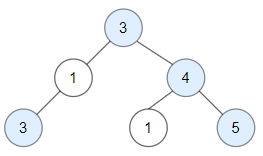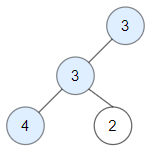Given a binary tree root, a node X in the tree is named good if in the path from root to X there are no nodes with a value greater than X.
Return the number of good nodes in the binary tree.
Example 1:
Input: root = [3,1,4,3,null,1,5]
Output: 4
Explanation: Nodes in blue are good.
Root Node (3) is always a good node.
Node 4 -> (3,4) is the maximum value in the path starting from the root.
Node 5 -> (3,4,5) is the maximum value in the path
Node 3 -> (3,1,3) is the maximum value in the path.
Example 2:
Input: root = [3,3,null,4,2]
Output: 3
Explanation: Node 2 -> (3, 3, 2) is not good, because "3" is higher than it.
Example 3:
Input: root = [1]
Output: 1
Explanation: Root is considered as good.
Constraints:
- The number of nodes in the binary tree is in the range
$[1, 10^5]$ . - Each node's value is between
$[-10^4, 10^4]$ .
題目給一個二元樹的根結點 root
定義一個結點 X 是 good 代表從 root 到 X 的值都不大於 X.Val
要累計這個二元樹是 good 的結點個數
關鍵點在於透過 DFS 還有累計當下最大的值來做符合條件的檢驗
package sol
import "math"
/**
* Definition for a binary tree node.
* type TreeNode struct {
* Val int
* Left *TreeNode
* Right *TreeNode
* }
*/
func goodNodes(root *TreeNode) int {
if root == nil {
return 0
}
count := 0
max := math.MinInt32
CountGoodNodes(root, max, &count)
return count
}
func CountGoodNodes(root *TreeNode, max int, count *int) {
if root == nil {
return
}
curMax := max
if curMax <= root.Val {
*count += 1
curMax = root.Val
}
CountGoodNodes(root.Left, curMax, count)
CountGoodNodes(root.Right, curMax, count)
}- 理解結點是 good 的條件
- 理解如何做 DFS
- Understand what problem to solve
- Analysis Complexity


